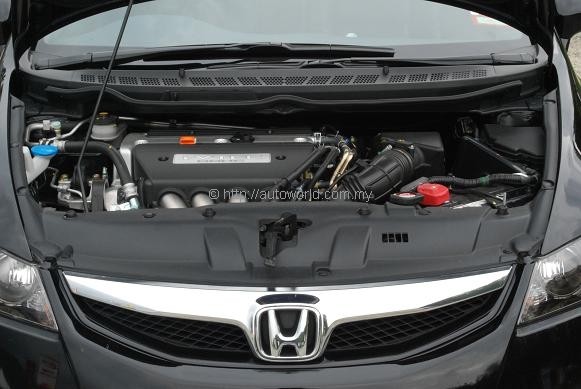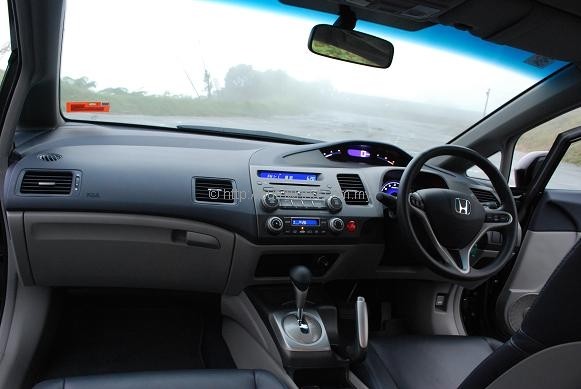The Perfect Mate? Honda Civic 2.0S
Recently, somebody posed a question on my potential choice for a life partner. It went, “Would you accept a girl that is perfect in every way…” It sounds very primary school, I know, but back to the question,”…she’s beautiful, she’s sexy, she can cook, she does all house work, she completely adores you – except…”
I stopped the question at that point for two reasons. First, a perfect person like that exists solely in the realm of fairy tales. We happen to live in a place called ‘reality’ Second, I didn’t need to hear what will follow after ‘except’ because it is bound not to appeal to me anyway, or this question wouldn’t have been posed.
Though I dismissed it at that time, the said question subsequently prompted me to ponder a little deeper after the conversation had subsided. What would life be like living with the perfect partner? A partner without flaws. A partner with whom we can blissfully live our wedded lives till death do us part. A partner who does no wrong.
That sounds tempting, but deeper thought suggests that as a prospect, complete bliss is hardly appealing. Think about it: no problems, no challenges, no difficulties for your entire life! Love experts tell me that a partnership that does not undergo any rigourous trials and tribulations will not develop into a lasting union. It may sound counter-intuitive, and many of us would not want to admit it, but on a deeper level, we thrive on challenges and difficulties. They make the whole process of life worthwhile.
Happily though, for most people the purchase of a car does not follow such paradoxical rules. Unless you’re a crazed petrol-head who love to get your hands dirty every evening with your old Alfasud, you would probably want a car that is perfect and flawless for whatever reason you’re buying it for.
For many people, the perfect car priced below RM130k is the Honda Civic. Pretty much in the vein of the ‘perfect wife’ that was postulated earlier, the Civic is handsome, sleek, spacious, powerful, agile, well-built, and too many other qualities to list down here.
Honda Malaysia recently loaned us a test car of the Civic for us to review. As I was scheduled for an assignment to Genting Highlands during the test period, HM’s timing, in the spirit of the subject discussed thus far, is best described as perfect as well.
The Test Car
The car loaned from Honda Malaysia was a Crystal Black Pearl unit of the facelifted 2.0S with a complete set of Modulo accessories consisting of front, side and rear skirts in addition to a bootlid-mounted spoiler.
When I collected the car from HM’s office in Section 13, PJ, it had already clocked in excess of 11,000 kilometres. There is little doubt that this car has been pretty well run-in by my colleagues from other publications.
Whatever that has been thrown at it for the past half a year as it went its rounds through various pairs of hands, the car has held itself together well. The bits and pieces in and out were as tight as new, with the exception of the front bumper that seemed a little out of alignment at the right side.
On its own, the Civic 2.0S costs RM129,980.00 OTR inclusive of insurance for folks in the Peninsula, but the Modulo kit on our test car adds a nice round RM5,000 to the sticker price. A fair price for a factory fitted bodykit, but I’ve never been fond of non-performance enhancing options, so that’s an option I’d leave out.
On Paper
You would probably have read enough reviews in various publications telling you that the Civic is the benchmark of the C-segment. Here’s the simple fact – they’re right. As far as the mechanical bits are concerned, the Civic is pretty hard to beat. Although the segment has become increasingly competitive, the Civic still has sufficient credentials to hold its own.
Powering the Civic 2.0S is the 1,998cc K20Z2 inline-4 DOHC i-VTEC engine. Producing 153hp @ 6,500rpm and 188Nm @ 4,500rpm, it comfortably deals with all 2.0-litre alternatives in the C-segment, with only the Mitsubishi Lancer GT (153bhp & 199Nm) able to match the Civic’s output.
As per standard practice across their range, the Civic gets an electronically controlled 5-speed automatic transmission as standard for both variants, with the higher range 2.0 getting paddle shifters. Honda would probably like to claim this as a class leading feature, but the Mazda3 2.0 offers the same transmission specification, while the Nissan Sylphy and Lancer has shifted the playing field to CVTs. Which of these alternatives is class leading is a matter of preference, you understand.
Nothing new on the other moving bits either, though they are on par with, or in some cases, exceed, the competition. Steering is rack and pinion, with the 2.0 getting electric power assistance in comparison to the 1.8’s hydraulic setup. All-round disc brakes and independent suspension are standard as well, with the rear axle held in place by double wishbones.
In the Showroom
Though the Civic received its scheduled mid-life facelift earlier this year, the car’s design is now in its fourth year. Fortunately, age has not diminished the Civic’s appeal, as its styling remains as sleek and futuristic as it was when first launched.
The recent plastic surgery ensures the Civic’s look remains fresh. The black paint of our test car has obscured some of the good work, even if it’s just the standard facelift operation of reprofiling the grille and bumpers.
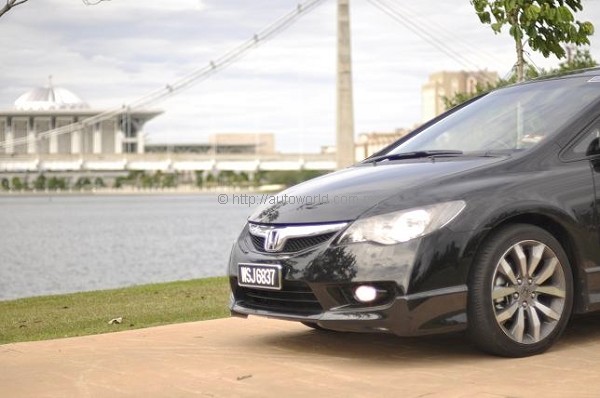 |
| Nose job was a minor op, but nicely done. |
Things continue to look good inside, with the two-tiered multiplex meters an instant source of attention and conversation. Whatever the inspirations of its designers were, the digital speedometer is a wonderful throwback to the likes KITT and the DeLorean of Knight Rider and Back to the Future fame respectively. That dashboard alone could probably have been responsible for half of the Civic’s stellar sales figures.
 |
| Couldn’t resist from re-enacting ‘Back to the Future’ fantasies… |
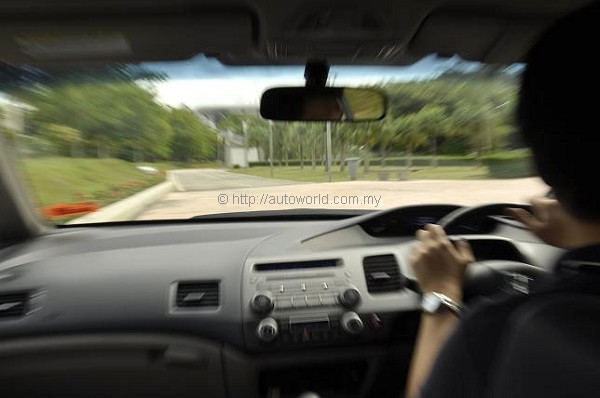 |
As you later expand your vision to examine the rest of the interior, you would notice that Honda has organized the Civic’s cabin to keep it inline with the sleek and futuristic image that the car seeks to project. The gear lever, handbrake, audio and electronic climate controls all seem to be sculpted with the Starship Enterprise as inspiration.
There are plenty of lidded storage compartments too, all neatly placed along the centre console allowing for the neat storage of your little bills and trinkets. It is a finely built and designed cabin, though those looking for a simple and conservatively styled interior may wish to look elsewhere.
However, despite its sci-fi inspired layout, there is very little ground-breaking stuff the Civic’s interior. It may look different, but the multiplex cluster still only houses a speedo, tacho, fuel gauge, water temperature gauge, and all the warning lights. Climate control is electronic, but it’s a standard single zone system. The audio unit has an AM/FM receiver, CD changer, and MP3/WMA compatibility. It is well equipped, but most of the Civic’s standard features are found in rivals – they’re just not encased in a shell that’s as futuristic looking.
On the Road
My review of the Civic lasted four days, a period which saw me traverse a distance of nearly 800km – covering destinations and road conditions as diverse as Genting, Bukit Tinggi and Putrajaya.
Settling down to a comfortable driving position was easy, as all controls were within easy reach. There was one problem though – the headrest, which to me, was angled too far forward. It was one aspect of the interior which I never quite managed to get comfy with.
Another problem was the angling of the foot rest, which felt just wrong. After my long drive back from Genting Highlands, my left foot actually felt even more tired than driving a manual car. Either Honda got the angling of the footrest slightly out, or I was having clutch withdrawal symptoms.
Fit and finish quality levels are high with consistent panel alignments. The controls have good tactile feel about them, and are very easy to operate. However, the bulbs used to light up the dash heat up very quickly. After driving extended kilometres with the headlamps on, the lighted parts of the dashboard felt worryingly hot.
Those were, of course, just minor grouses in an otherwise well engineered machine. The K20Z gives excellent take off acceleration, with the auto gearbox responding well to sudden jabs of the accelerator. It does not produce a very sweet note (it’s more like a shriek at high revs), but the engine gets the job done very effectively. The Civic was never found wanting when the need for urgent acceleration arises.
The transmission pairs well with the engine. Upshifts are performed with great smoothness, while kickdowns are executed with urgency. Downshifts are readily executed upon detecting a downward slope, enabling the effective use of engine braking to control descent. It responds to inputs from the paddle shifters promptly, very useful when you’re triggering the downshift to summon extra cornering traction.
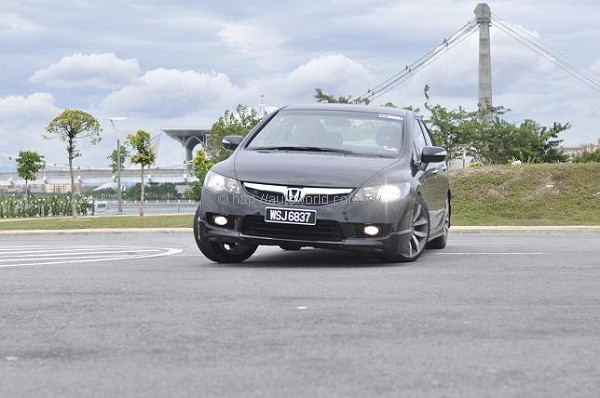 |
| Dry cornering grip is excellent |
The suspension is tuned to give a fine combination of ride comfort and handling prowess. Though its chassis does not have the same breadth of talent as the excellently balanced Ford Focus, it still handles the rigours of spirited driving well. With the transmission set to manual shifting mode, the Civic dispatches sweeping bends with great poise and composure.
The 215/45 R17 Michelin Pilot Preceda tyres have excellent cornering grip on dry surfaces, but I’d advise you to take it real easy when the heavens open their taps. Damp road surfaces altered the handling limits quite dramatically. At the very same corners on which it seemed to corner on rails earlier, it understeered significantly (with VSA ON) after a light drizzle. On one occasion, I even encountered lift-off oversteer when taking a corner down hill.
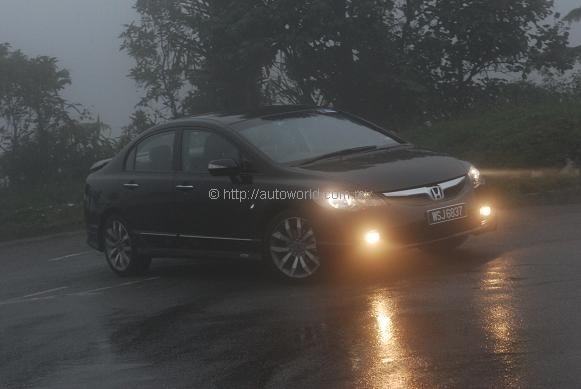 |
| Take it easy in the wet though! |
Once the roads dried up, however, the Civic was back in its element. On long straights at speed, it felt stable and planted. The fifth overdrive ratio keeps engine revs low, which is a good thing, as the Civic’s noise insulation isn’t exactly up to RM130k standards.
Corners, meanwhile, are taken with great poise and composure. The electric power steering weighs up nicely at speed, allowing you to power through corners with supreme confidence (reminder: dry roads!). Its ride is biased in the direction of stiffness, though not bone-jarring. Won’t appeal if you’re looking for a wafting ride though.
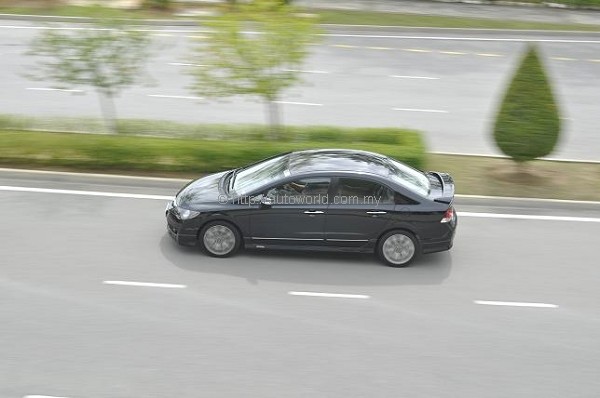 |
| Ride is a little stiff, but straight line stability is good. |
On Reflection
There’s very little wrong about the Civic, as this test merely served to confirm its position as the benchmark of its segment. Its strength lies not in the fact that it excels in any one particular criteria, but simply because it does everything expected of it very well.
If you look at the various aspects of the car in isolation, the Peugeot 308 has a sweeter engine and more goodies, the Lancer GT has greater driving appeal, the Altis & Sylphy would be more comfy, and the Ford Focus has a much better sorted ride & handling. But where the abilities of these cars are skewed to centre on their strengths, the Civic excels as the all-rounder.
The only real criticism we could probably level at the Civic is that, at its price, which isn’t cheap to begin with, it is a little under-equipped compared to some rivals which offer more for less. Items such as auto headlights, dual zone climate control, rear blowers, one-touch indicators, and digital trip computers, standard in some rivals, are not even options on the Civic.
The Civic remains as the car to beat in the C-segment. No other competitor offers the same blend of styling, space, handling, and performance. The only reason that you wouldn’t want one is if the idea of a perfect and (nearly) flawless mate does not appeal to you.
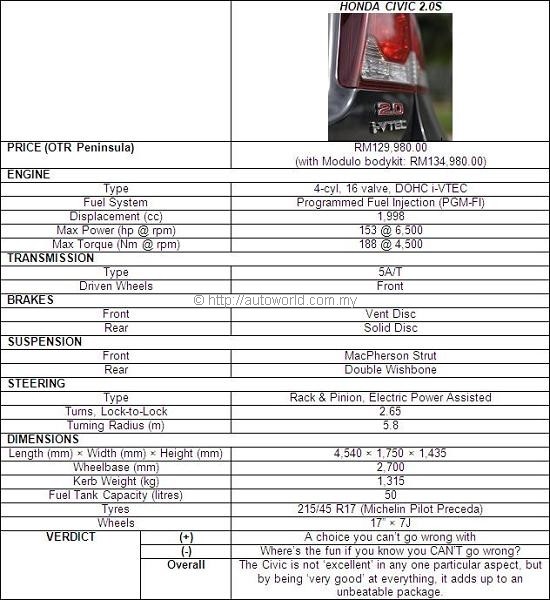 |
Photography by: Trius Blades & Kon






